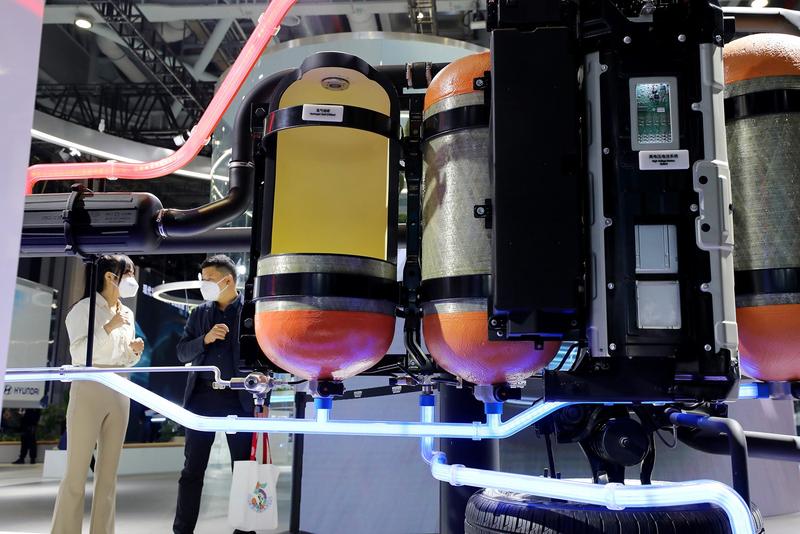Policy support combined with innovation to speed up usage, reach carbon goals
 Visitors check out hydrogen fuel cell technologies that help power vehicles during the fifth China International Import Expo in Shanghai on Nov 6. (FANG ZHE / XINHUA)
Visitors check out hydrogen fuel cell technologies that help power vehicles during the fifth China International Import Expo in Shanghai on Nov 6. (FANG ZHE / XINHUA)
China's development of the hydrogen energy industry is on a fast track driven by policy support and market demand, with innovative technologies, new applications and mechanisms constantly emerging, experts said.
More efforts are expected to accelerate technological breakthroughs, expand the application of hydrogen fuel cells in areas such as rail transit and power supply to achieve new green and low-carbon growth, accelerate the development of hydrogen made from green sources and step up global cooperation in the sector, they said.
According to the National Development and Reform Commission, at present, China is the world's largest hydrogen-producing country, with annual hydrogen production of about 33 million metric tons
The remarks were made at the recent China Hydrogen Industry Conference held both online and offline in Beijing and Foshan, Guangdong province.
Hydrogen energy involves the use of hydrogen and hydrogen-containing compounds to generate clean energy.
According to the National Development and Reform Commission, at present, China is the world's largest hydrogen-producing country, with annual hydrogen production of about 33 million metric tons. The country now has over 300 hydrogen companies whose annual revenue surpasses 20 million yuan ($2.8 million).
Shen Zhulin, an official with the NDRC, said: "With the acceleration of the scientific and technological revolution and industrial transformation, hydrogen energy has gradually become a new focus of global strategic competition, an important direction for countries to cultivate emerging industries, and an important way to promote the green and low-carbon transformation of energy production and consumption under the consensus of countries to actively cope with climate change."
Zhang Xiaoqiang, executive vice-chairman of the China Center for International Economic Exchanges, said the development of hydrogen energy is of great significance to help China peak carbon emissions by 2030 and reach carbon neutrality by 2060.
In March, the NDRC and the National Energy Administration co-released a mid and long-term development plan for China's hydrogen energy industry, which stated that the industry is an integral part of China's energy system and it will promote the low-carbon transition of areas like transportation, industry and other energy-intensive sectors.
According to the plan, China's hydrogen energy industry is now showing a positive development trend. Major technologies for hydrogen energy production, storage and transportation, hydrogen fuel cells and other sectors have been preliminarily mastered, and small-scale demonstrative applications of hydrogen fuel cell vehicles have been realized in some regions.
The plan said that by 2025, China will master core technologies and manufacturing techniques. The number of hydrogen fuel cell vehicles will reach about 50,000.Meanwhile, a number of hydrogen refueling stations will be built, and the amount of hydrogen produced from renewable energy will reach 100,000 to 200,000 tons per year, which will reduce carbon emissions by 1 to 2 million tons per year.
 A woman scans a QR code on a shared hydrogen-powered scooter in Changzhou, Jiangsu province, in December 2021. (XIA CHENXI / FOR CHINA DAILY)
A woman scans a QR code on a shared hydrogen-powered scooter in Changzhou, Jiangsu province, in December 2021. (XIA CHENXI / FOR CHINA DAILY)
Xiang Haiping, chief engineer of the NEA, said that China attaches great importance to the development of the hydrogen energy industry. Up to now, more than 20 provinces, autonomous regions and municipalities have issued documents on hydrogen energy planning and guidance.
"Encouraged by national and local governments, State-owned enterprises, private firms and foreign companies have shown great enthusiasm for the development of the hydrogen energy industry. In the Yangtze River Delta region, Pearl River Delta region and Bohai Economic Rim area, the hydrogen energy industry is forming industrial clusters," Xiang said.
"In terms of hydrogen energy production, projects of hydrogen produced from renewable resources have been actively promoted in North and Northwest China, and the cost of hydrogen produced in the electrolysis of water has been decreased in a stable manner. As for hydrogen energy filling, more than 280 hydrogen refueling stations have been built, ranking tops in the world," Xiang said.
In terms of applications, in addition to the traditional chemical, as well as the iron and steel industries, the use of hydrogen has also been steadily promoted in sectors such as transportation and construction, Xiang said.
Local governments have also stepped up efforts to encourage the development of the hydrogen industry. Guangdong province has leveraged its strengths in car manufacturing to ramp up the development of a hydrogen fuel cell automobile industry cluster. Shandong province has also beefed up efforts in building hydrogen energy industrial parks and equipping highways with hydrogen refueling stations.
"Commercial vehicles are the key and a difficult point of carbon reduction in the automobile industry. Taking heavy trucks as an example, although the number accounts for about 7.9 percent of the total, they are responsible for 47 percent of carbon emissions among all types of vehicles. The application of hydrogen fuel heavy trucks will help accelerate the low-carbon transition of commercial vehicles," Zhang said.
"It is necessary to continue to intensify technological research and development efforts, give full play to the leading role of enterprises in innovation, support the deep integration of industry, universities and research institutes, and form an efficient collaborative innovation system. At the same time, it is important to cultivate hydrogen energy professionals," Zhang said.
Wan Gang, chairman of the China Association for Science and Technology, said China's development of hydrogen has entered a new phase. "It is important to further explore the development of green hydrogen and its relevant trading market."
Green hydrogen is obtained through renewable energies while gray hydrogen — the most common form of hydrogen production at present — is created from gas or methane, causing greenhouse emissions.
According to the NDRC, compared with gray hydrogen, China's market size for green hydrogen is still relatively small but is showing an active developing trend.
Wan said that during the Winter Olympics and Paralympics this year, about 1,200 hydrogen fuel cell vehicles were used, which helped reduce carbon emissions by some 2,200 tons.
Currently, areas in North and Northwest China, such as the Inner Mongolia autonomous region and the Xinjiang Uygur autonomous region, are stepping up efforts to leverage their abundant wind and solar resources to develop green hydrogen. "The sector is showing good momentum," he said.
Jing Chunmei, director of scientific research and information at the China Center for International Economic Exchanges, said currently, factors like high storage costs and insufficient transportation capacity still hinder the development of green hydrogen.
"Going forward, efforts are expected to set up a national standard to define purity and other parameters of green hydrogen, optimize sources of green hydrogen generation, promote a more efficient transportation system and encourage more use of green hydrogen in the industry sector," Jing said.
"Moreover, it is important to reduce costs through efforts such as encouraging innovation in technologies, business models and structural reforms to make hydrogen power generation profitable," she said.
"In order to encourage hydrogen production from renewable resources, subsidies can be given to encourage hydrogen energy companies and hydrogen storage businesses to participate in power trading, because the power generated from green hydrogen and gray hydrogen does not have a comparative advantage in price without subsidies," she added.


